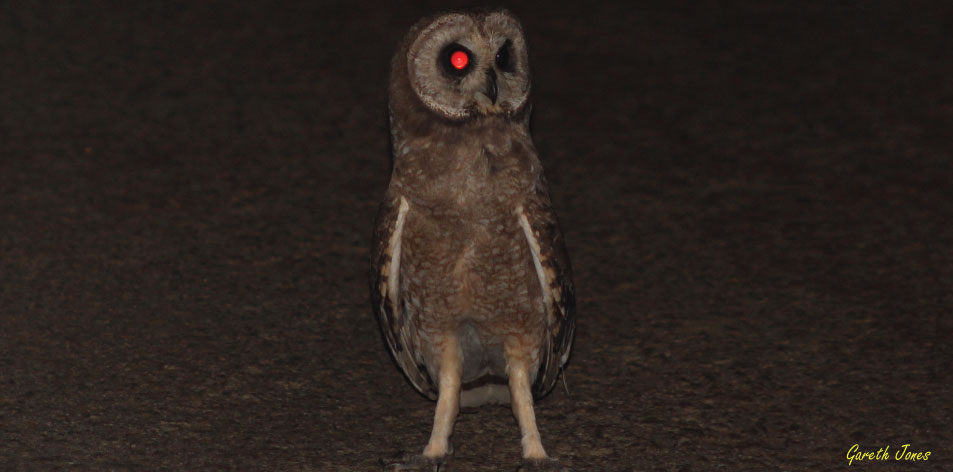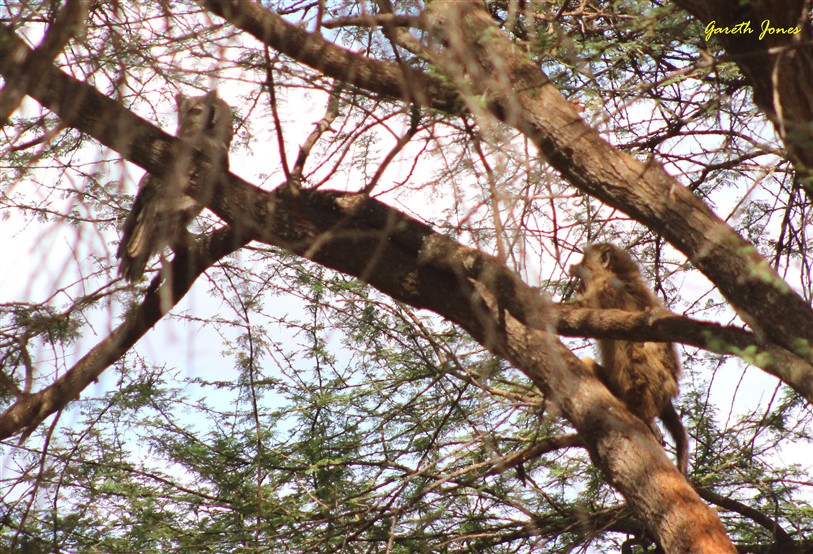
The Stealth Striker!! – Article by Gareth Jones
The Stealth Striker Of The Nairobi National Park
It was a cold, dark, moonless night as the little baby shrub hare followed its mother to find suitable food to satisfy their hunger. One moment “mom” was in front, then suddenly “mom” seemingly disappeared upwards, as a pair of sharp powerful talons grabbed her. Mercifully, it was a quick ending, as the “Stealth Striker” successfully captured another nightly meal. It is difficult for humans to imagine what it is like for a creature to have the phenomenal design and extraordinary senses that make it an apex nocturnal predator. These incredible “stealth striker” creatures are the various Owl species. All owls are carnivorous birds of prey and predominantly live on diets of insects, small rodents. Some owls are also specifically adapted to hunt fish. They are very adept in hunting in their respective environments. The amazing combination of virtually silent flight, excellent colour camouflage, pinpointed location hearing, night vision eyes on a head that can rotate up to about 270 deg, large sharp talons and an efficient beak that easily tears prey apart is why owls have a well-earned reputation a very successful nocturnal hunters.
Most owls share an innate ability to fly almost silently and also more slowly in comparison to other birds of prey. Being able to fly without making any noise gives owls a strong advantage over prey that might be alert to the slightest sound in the night. Serrated edges along the owl’s remiges bring the flapping of the wing down to a nearly silent mechanism. The serrations are more likely reducing aerodynamic disturbances, rather than simply reducing noise. The surface of the flight feathers is covered with a velvety structure that absorbs the sound of the wing moving.
Owls exhibit specialized hearing functions and ear shapes that also aid in hunting. They are noted for asymmetrical ear placements on the skull. Asymmetrical ear placement on the skull allows the owl to pinpoint the location of its prey. With ears set at different places on its skull, an owl is able to determine the direction from which the sound is coming by the minute difference in time that it takes for the sound waves to penetrate the left and right ear. The owl turns its head until the sound reaches both ears at the same time, at which point it is directly facing the source of the sound. Even the almost dish-like arrangement of the facial feathers of most owls also aids to increase their hearing ability.
Apart from their phenomenal hunting reputation, Owls are also famously associated with being wise. There are for example well known sayings like “to be as wise as an owl”. In reality, owls are not that wise, but perhaps their ability to efficiently use all the natural talents effectively when hunting could be a factor in aiding their legendary reputation. Perhaps, their facial features do also have a very “considering and deep thinking” look that seemingly oozes with “wisdom”.
Why do owls hoot at night? This is mostly because they are protecting their territory from other Owls. Screeching or low barking occurs at times because they feel threatened or need to protect their territory. Very often they hoot to attract a mate and begin setting up their territory. From a human viewpoint, just sitting quietly and listening to an owl hoot, is somehow rather therapeutic and relaxing at night.
In and around the Nairobi National Park, there are at least 8 recorded owl species, ranging from rare seasonal visitors to occasionally seen residents. Previously recorded species include Pel’s Fishing Owl, Verreaux’s Eagle Owl, Spotted Eagle Owl, African Wood Owl, Barn Owl, Pearl spotted Owlet, Marsh Owl, African Scops Owl. Wow! Such an amazing variety of species, just imagine seeing a Pel’s Fishing Owl in the Athi basin. Well, I guess we can all have dreams, that hopefully become reality one day.
The park has a great variety of birds when compared to the world. Worldwide, it is estimated that there are about 10,000 bird species, in East Africa it is estimated that there are just under 1,500 bird species, and a tiny little place of less than 117sq km, that we call the Nairobi National Park has as many as 550 species at certain times. A bird identification book for East African species is also useful to keep in the car when driving. To have owls living so close to a major city is unique. They need to be protected, and the Nairobi Park is a safe haven for them to nest and breed. However, as they can fly, they often fly out of the park boundary, citizens need to be aware of the vital role of raptors such as Eagles, Hawks and Owls, they eat rodents, frogs, lizards, and snakes, and therefore ensure a healthy balance in nature.
God has created so such amazing diversity, and owls are truly unique and incredible creation in their role as “Steath Strikers”.
The park is open daily from 06h00 to 19h00



